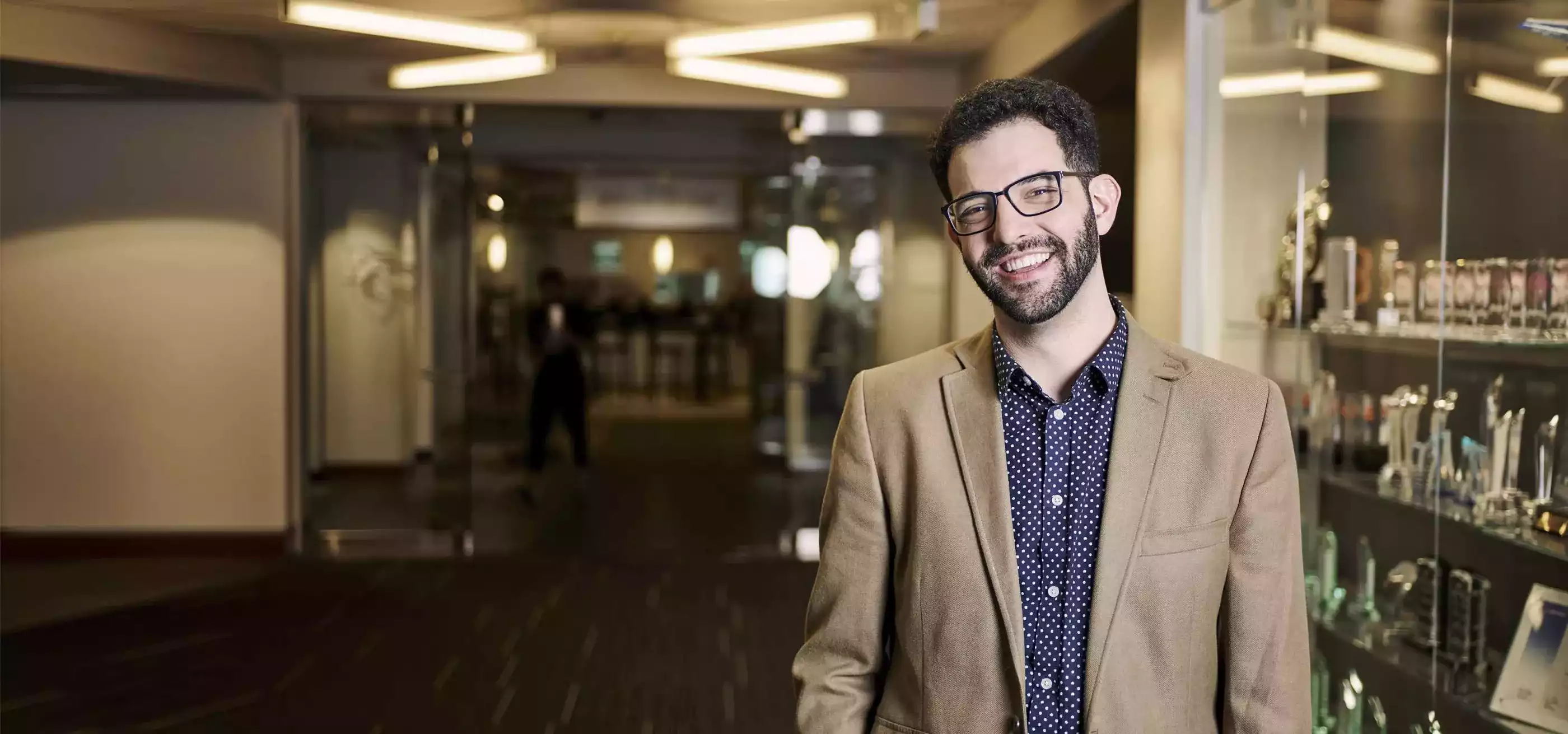DigiPen is a leader in digital arts education, but that doesn’t mean our students don’t get their hands dirty. In Professor Danny Samuels’s Miniature Set Design and Fabrication course, it’s not uncommon to end the day partly covered with Elmer’s glue and stray bits of Styrofoam. “I like to photograph these students’ sets on the same grey gradient backgrounds that 3D models are rendered in,” Samuels says. “My favorite thing is when another teacher goes, ‘This looks great! What program did you have them do this in?’ And I get to say, ‘it’s this program called ‘A Knife and Some Foam!’”
Samuels knows a thing or two about making visually stunning models and sets. Beyond his work at renowned Portland stop-motion studio Laika, where he contributed his miniature prop-making skills to The Boxtrolls and the upcoming feature film Missing Link, he’s also built sets for Adult Swim’s stop-motion sketch comedy Robot Chicken, as well as the life-sized scenery for Disney theme parks. Today, he teaches students how to build gorgeous physical miniature sets — mimicking rock, wood, and metal textures to create environments that look both realistic and stylized. We caught up with Samuels to talk about his model-making background, his unique DigiPen class, and the nightmare that Disney World’s “It’s a Small World” becomes after dark.
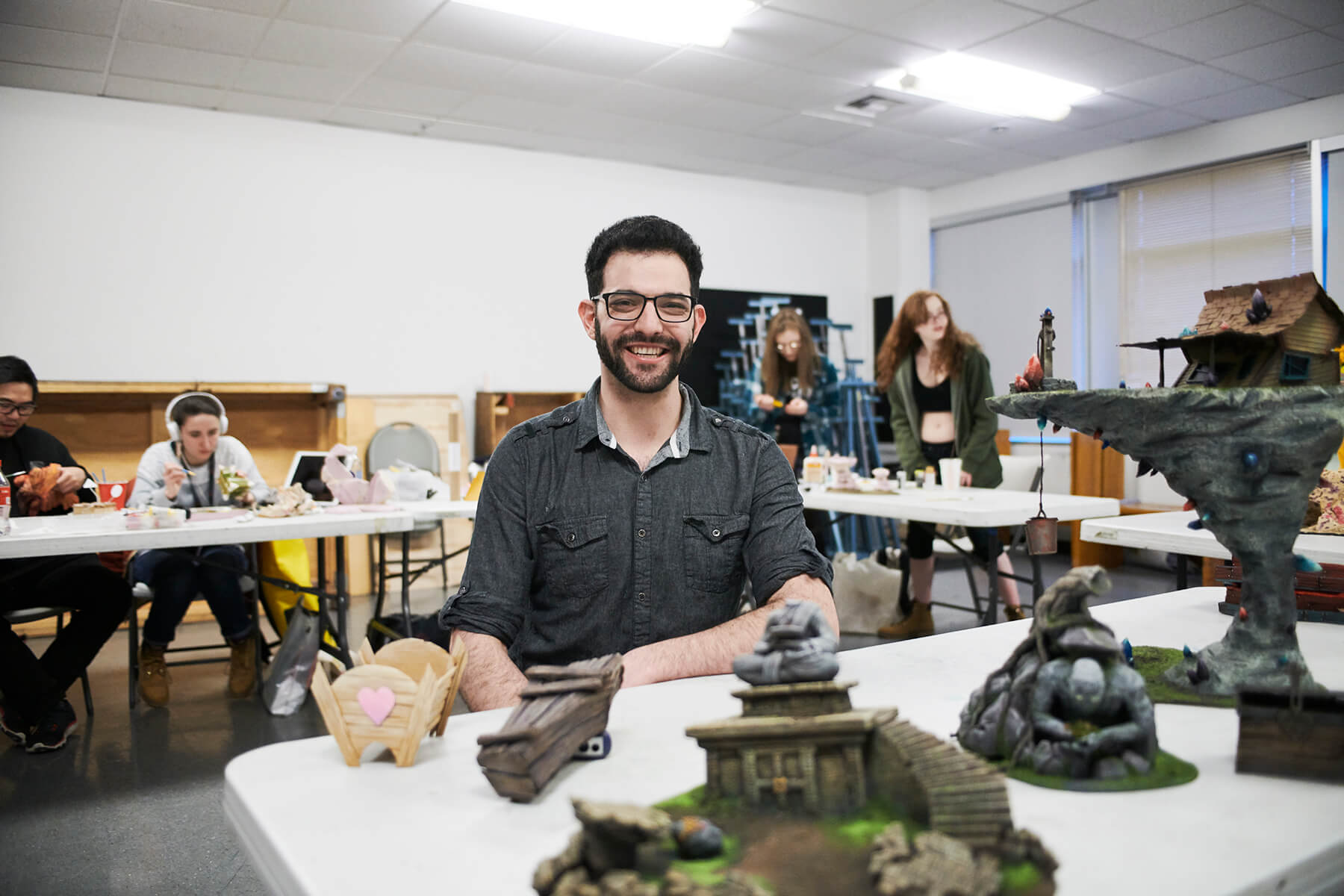
Before we talk about your Miniature Set Design and Fabrication class, tell us how you initially got into model making?
I grew up always drawing and painting but I had trouble paying attention, so I’d always have clay in my hand so I could fiddle with something. Then, I got into games like Warmachine, Confrontation, and Warhammer, which are miniature tabletop games. At that time I couldn’t afford the figurines. So what I did is this. In the game, you have crazy terrain on your board that you put your models on. Since I couldn’t afford the models, I would build terrain and trade it in for the figures at the store, so they could have some great looking terrain to use. [This was] back when I was 14 or 15. I continued to draw and paint and went to college trying to be a concept artist. We’d have all these crazy gallery shows, and the way I’d get into them was doing these sculpture pieces. When I was a junior, Laika opened up an internship program. I submitted my sculptures, and I ended up getting the first art internship there.
What was Laika like as an intern?
When I started they were right at the beginning of The Boxtrolls. They were still even doing a little bit of look development for it. By the end, I’d done hundreds of foam mock ups and got to make a few fun props seen in the movie. After graduating college, I went back for a second internship, and at the end, my boss at the internship said, “We’d like you back one day.” But the model shop there requires such a specific skillset — it’s very hard to get in there. You have to know metal working, sculpting, wood fabrication. You have to know how to carve and turn RenShape [a brand of modeling board] and use different forms of plastics. It’s a lot. So he said, “I need you to hit these companies, go to L.A., learn some more skills, and then maybe we’ll have you back.” So I went to L.A., ended up working for most of the companies he mentioned, even went to Florida to be a Disney Imagineer for a bit. Then I was able to go back to Laika, where I worked on Missing Link for about a year and a half. I’m credited as a full-fledged model maker on Missing Link. I must have made about 140 props for that film by the end.
When you went to L.A., you even worked on Robot Chicken for a bit?
That was my first big job. Right before my internship ended, Robot Chicken called me and hired me on as a junior model maker. It was me and four to five other people, and we would build everything, like the entire set. It was crazy. We did that for seven months, and it was the most insane experience of my life.
What made it so intense?
So, Laika is really cool, because every time they make a movie, they’re trying to set a new bar and push the medium of stop-motion animation. I spent over a week or two developing weird, gross examples of stew for Missing Link. There were full-on metal rigs inside the balls of stew noodles, so they could animate them individually step-by-step. We had time to develop all that stuff, so Laika is crazy in that sense. But at Robot Chicken, you get handed a rough storyboard. Sometimes they are drawn so quickly it could have been on a napkin, and it’s like, “OK, this is a scene in Narnia. Go make the Narnia set.” You have a few days to design, build, and paint everything before the art director needs to approve it. At Laika, it’s more like, “OK, make a vase, make a rope, make some taxidermy. Here is some concept art. Take your time and make it look amazing.”
Can you tell us a bit about what you did at Disney in Florida?
I was in a division called the scenic shop, where we would paint, build, and sculpt stuff for Disney World in-house. It was life-sized work for the most part, but miniature sculpture and fabrication techniques all scale up. Work eventually slowed down, so another shop kidnapped me — it was for a night shift at a division called Figure Finishing. Essentially you are given a work order, and they say, “This animatronic needs to be retouched and repainted on its neck before the park opens.” So you’re walking around Disney World at night with a headlamp and a paint kit, and it’s the stuff of nightmares. It’s terrifying. Walking into “It’s a Small World” at night, it’s nuts! Sometimes there’s residual air in the animatronics’ tubes. So you’ll be painting and the head will shift slightly all of a sudden.
Then, finally, I got kidnapped into Imagineering, and I was doing development work on-site for the world from Avatar, Pandora, as an expansion for the Animal Kingdom. So they’d say, “Find a cool way to sculpt these strangler vines” or “make 40,000 glowing plants, and figure out how to do it quickly.”
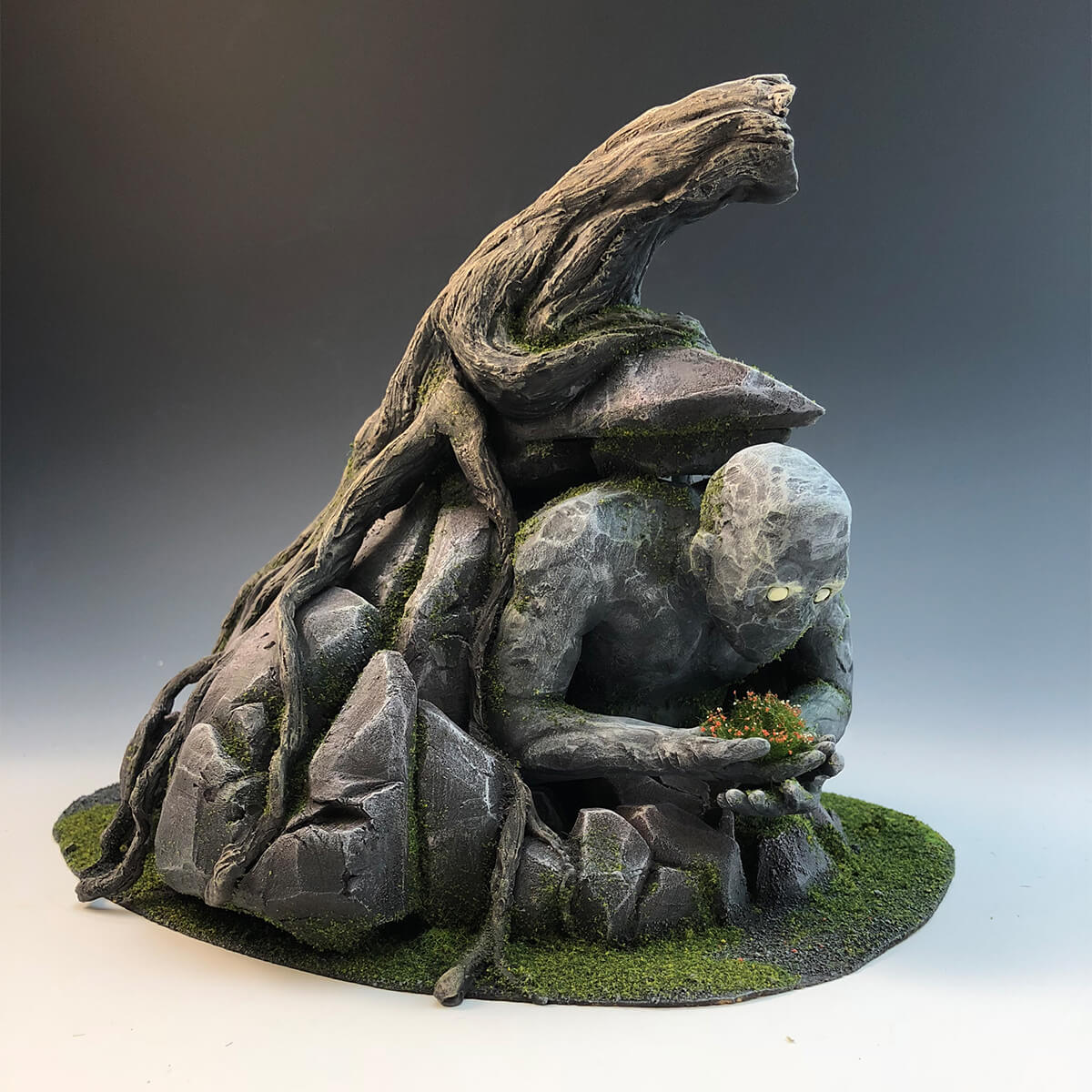
In the rubric for your class, you mention that the skills you learn in miniature model making aren’t constrained to use in stop-motion animation — they have a lot of other applications in different industries and production pipelines. Can you elaborate?
One of the funny and common misconceptions about my class is that it’s the “Laika” or the “stop-motion fabrication” class. Do I want you to come out of this class with modeling and sculpture skills? Absolutely. Do I want you to go into the industry and do exactly what I do? Absolutely not. I encourage you to do whatever you want, but this class is a theory- and principle-based class, and in that sense, it applies to everything. Art and design is all the same. It all breaks down into the same principles of composition, hierarchy, color, value, and so on. I’m teaching you those principles in this class — it’s just that you’re learning them through making tiny houses, basically. It’s applicable to a wide variety of things.
Say you’re an environment artist and you want to make the compositions in your video games stronger using light and value and texture. In this class, you’ll learn how bricks weather in certain types of rain or how rust on metal drips down. Also, if a recruiter sees a cool digital model and then they also see a physical sculpt of it, they love it. At the Career Fair, if you have a really cool sculpture on the table, people are going to come up!
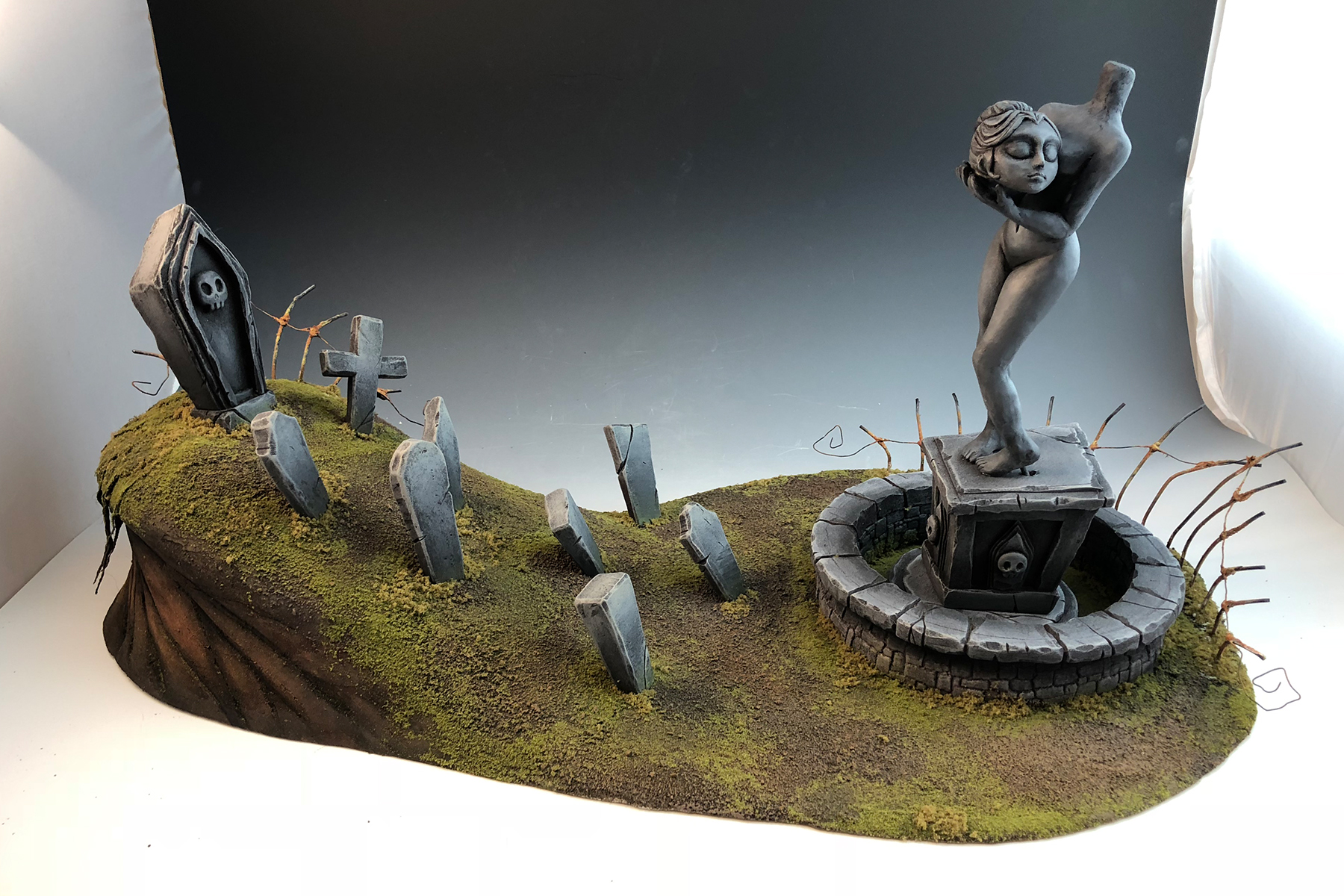
What materials do students use in your miniature model class?
We use a ton of pink insulation foam — that high-density Styrofoam you buy at Home Depot. Almost everything you make is made out of that. Then it’s a lot of balsa wood. Also, toothpicks, Elmer’s wood filler, foam core, cereal box cartons, and a lot of Fred Meyer cards, which are made out of a material called styrene that you can cut with an X-Acto knife and texture and bend. When we learn how to imitate metal textures, I show them how you can grind and dull a nail to divot the plastic and emboss rivets.
It says in your course description that students first learn how to imitate rocks, then wood, then metal, then put it all together to make larger environments. Can you tell us how those lessons build on one another?
We start with a rock because it’s a great way to learn from real-world reference. I want them to find a picture of a real rock and then design and build a cool version of that rock! It’s a great way to learn how to work with Styrofoam and the particular motor skills you need to carve it. It’s also a great way to learn how to do something called “composing in the round.” Essentially, in the same way you need to think about how the eye travels in a flat 2D illustration, you need to do the same with your model, this three dimensional object. You can’t just think about it from one side — the composition of that object still needs to be visually interesting no matter which way you turn it.
Then they make a wooden prop: a crate. A crate, though, could be a coffin or an actual crate of apples — anything along those lines. I want them to learn how to use balsa wood, how to add different kinds of wood grain to it, and how to stylize it or make it more realistic.
Then we can apply all of that in the final project and make this big cool exterior environment, and in that, we learn how to really design something and really dig into that aspect of the process.
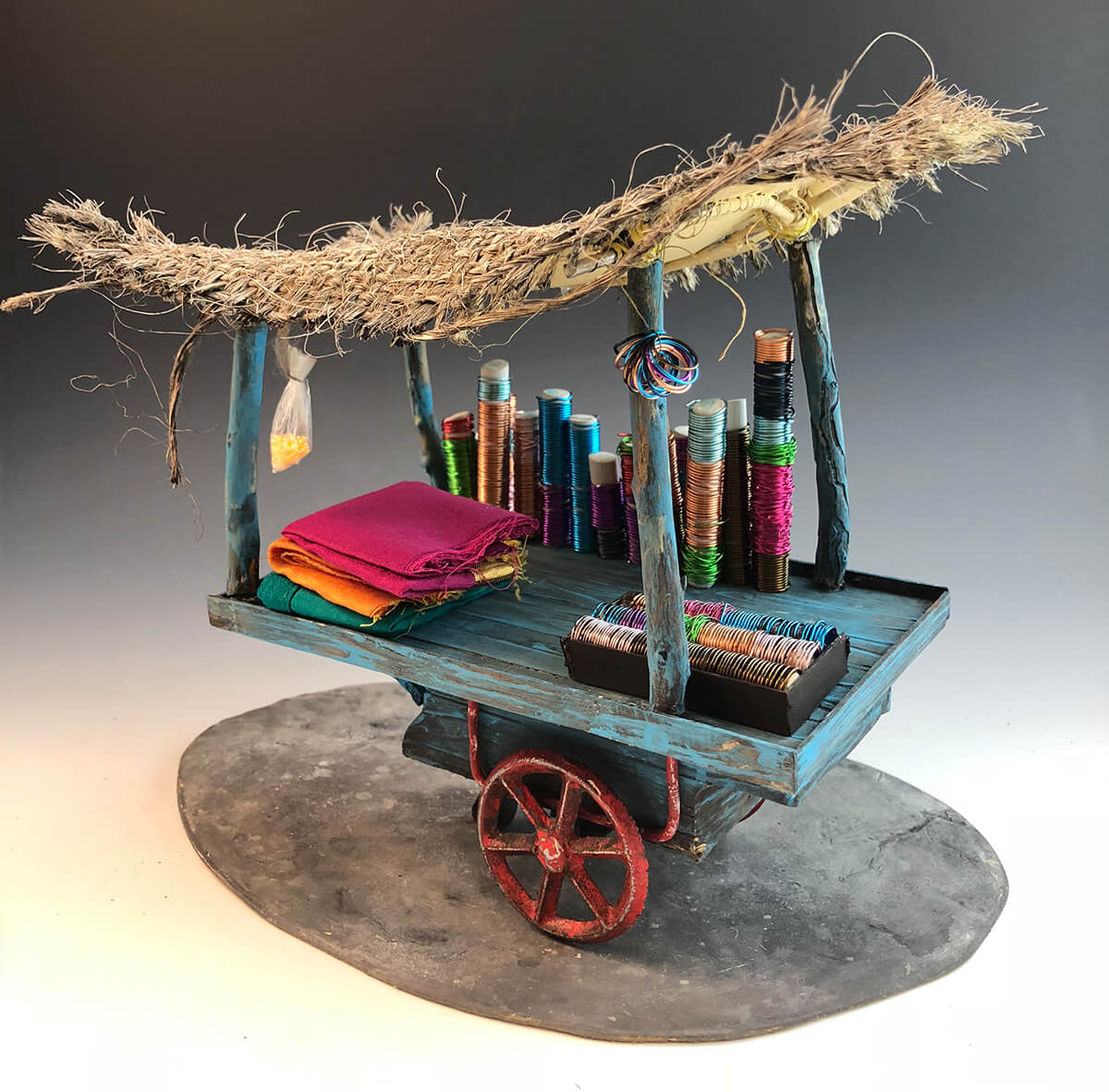
What’s the trickiest thing to learn when it comes making models?
Carving that foam, especially at the beginning. There is a touch to it. If you push the knife, the foam is going to tear. But if you slide the knife, it will beautifully slice through. That’s something I demo in the first class, just showing exactly what the motion is. That’s something a lot of people struggle with at first — there’s a lot of ripped foam that first class. People pick it up fast though!
Do you hear from students using their miniature sets after class for other things?
I am working with a film team who is doing 2D animation on top of real miniature sets they’ve built using the techniques they learned in my class. I know that two or three of my students showed off their sculpture work to game studios at the Internship Fair, and the companies freaked out. They were like, “Oh my god, if you can also model this digitally, you’re in.” I got an email too from a student who is a storyboard artist at DreamWorks now, and she said she’s using all the composition skills she learned in my miniature class in her work, even though she’s not sculpting. Like I said, it’s all the same principles!
